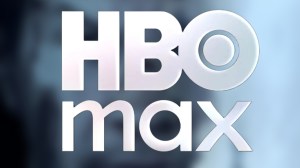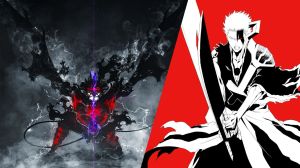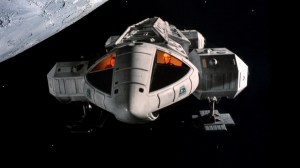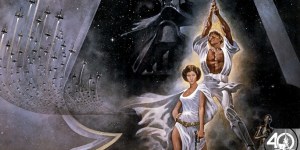
When I sat down to read Wytches #1 it was only 3 in the afternoon. I had to turn on a lamp though because it had quickly gotten dark outside; a big thunderstorm was blowing in. I was a few pages in when a torrent of rain began hammering the windows and thunder erupted across the sky. I’m not saying there’s a connection. That would be superstitious, silly even. I don’t believe in monsters. But that doesn’t change the fact that when I finished Wytches #1, every light in my apartment was on and the blinds were drawn shut.
Videos by ComicBook.com
Wytches is terrifying.
From the very start, Wytches seeks to set a potent, oppressive mood. The first two pages are the repetition of a single image, a definition of the word “witch” in an old, beaten typeface. Between the first and second page, the words are scratched and torn as if by fingernails. These are not pages of text. They are the first two panels of the comic. Something just out of sight reached out and defiled these old words. Something dangerous and ancient just happened, and you didn’t even see it. Those two pages set the tone for this series perfectly.
Clem Robins’ lettering in these opening pages and for the title itself is perfect. It’s no surprise to discover that he previously worked on Hellblazer for almost one hundred issues. His understanding of the power of design, and of letters specifically, makes this simple introduction tremendously powerful.
Scott Snyder has a reputation for being one of the best writers of horror working in comics today and it is completely deserved. He’s brought frightening overtones to some of his work on Batman, like in “Death of the Family”. American Vampire, Severed, and the first half of The Wake are all set firmly within the genre. Yet in all of his work, he has never veered too close to nihilism or outright pessimism. Even in darker stories like American Vampire and Severed without clear happy endings, protagonists at least have the ability to combat their monsters. Wytches presents no sense of optimism or hope. This is already the darkest tale Snyder has ever written. Nothing before it comes close.
The scope of this comic is much more personal than almost anything Snyder has written before. It is focused on the concept of family. Both the prologue and main story are introduced with a narrative caption announcing the family name and the year. The modern story centers around a family of three. Charlie and Lucy Rooks have just moved themselves and their daughter Sailor to a small town. They’re a tightly knit and affectionate family unit. Snyder composes small rituals that provides them with history and makes them easy to invest in. It even appears that Snyder has invested a little bit of his own family into this story. Charlie creates comics for a living and Lucy work in medicine, like Snyder and his own wife.
Wytches presents ideas, as well as characters, that are easily relatable. Much of the family’s conflict centers around attempts to create a better home in spite of the pressures of the outside world. Charlie, Lucy, and Sailor all have an intense desire to change their own world in a seemingly unattainable way. This reflects the desire of all parents to protect their children and of all children to be safe from harm. The first issue also introduces the concept of “pledging”, where humans are traded to wytches in return for some unnatural favor. That concept of wish fulfillment in relation to the strong wishes of a family creates an air of tension, one where evil may be able to prey even on good people.
The monsters in Wytches aren’t out to destroy the world. They’re here to destroy a family. Snyder understands that idea has far greater potential to be terrifying.
It does not take long for horrible things to start happening to the Rooks. Supernatural and very real tragedies are brought into the fold in rapid succession. The stranger elements read like a fever dream. When a person is attacked or an animal behaves oddly (an understatement to say the least), artist Jock pulls out the horror of these inversions of the natural order. What little is seen of the wytches themselves is exaggerated and grotesque. Their action and consequences on the natural world are far worse. Every form that is affected by these monsters is based on something real, but becomes twisted in their reach. This alteration of the real world and easily recognizable elements sets the horror close to home. Jock sets the story in a house near a woods that could potentially be projected onto almost any of the fifty states.
Jock focuses primarily on characters in most panels. Background and horror elements only come forth when they are required. His ability to focus on the mundane and human aspects of the story, portraying the Rooks family as a relatively typical, loving group, makes it all the more effective when sequences become surreal. He also has a keen eye for body language and expressions. Conversations between each of the Rooks are informed just as much by how they hold themselves and look at one another as by what they say. That adept understanding of human language also allows him to shift the visual tone of Wytches dramatically when showing what is clearly unnatural.
Colorist Matt Hollingsworth plays a big role in setting the mood. Hollingsworth previously worked with Snyder on The Wake where he contrasted the dark, claustrophobic tones of one half of the series with the bright, open world of the second. He applies a similar set of palettes to Wytches, but uses them to quickly shift the tone of the book within a single issue. An early sequence that takes place next in the Rooks family’s front yard uses soft greens, blues and browns to create a world filled with life. There’s no room for fear or angst in this sequence. It creeps in from there.
The first hints of darkness emerge in the forest adjacent to the house when a mysterious man appears. The trees are laced with darkness, but there is still some daylight filtering into the panels. It’s not an overt tonal shift, but a quick beat of foreshadowing. It warns the reader that there is darkness here, resting just on the edge of town. From there, progressively more darkness leaks into the panels. Fans of The Wake will recognize Hollingsworth’s potent blues and blacks as they consume the light. The effect is chilling.
The result of all these distinctive creators collaborating together is a story that is truly capable of inspiring fear. Wytches constructs a world where things beyond human comprehension lurk in the shadows. They are monstrous in both form and nature and they are interested in you. As a parent or a child, they reach out and twist the love you feel and turn it into stark terror.
Wytches is the scariest thing you will read all year. You’ll want to look away, but will find it impossible. So turn the lights on, lock the doors, and don’t look outside. Wytches is coming.
Grade: A
Wytches #1 will be released October 8 from Image Comics.
The final date to pre-order Wytches #1 is Monday, September 15th.








